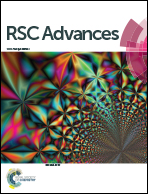Isosorbide bis(methyl carbonate) synthesis from isosorbide and dimethyl carbonate: the key role of dual basic–nucleophilic catalysts†‡
Abstract
Isosorbide bis(methyl carbonate) (IBMC) is a scarcely studied green chemical with potential applications in the manufacturing of non-isocyanate polyurethanes and bisphenol A-free polycarbonates. Its synthesis by transesterification of isosorbide with dimethyl carbonate (DMC) is very negatively influenced by the presence of small amounts of acidic impurities in isosorbide when heterogeneous inorganic carbonates such as potassium and cesium carbonates are used as catalysts. In this paper it is shown that the problem can be solved by using homogeneous catalysts consisting of nitrogenated bases and superbases having a suitable dual nucleophilic–basic character and able to form a highly reactive acyl intermediate with the electrophilic reactant DMC. Cycloaliphatic secondary and tertiary amines, guanidines and amidines covering a nucleophilicity parameter (N) range between 13.58 and 20.58 in either acetonitrile or dichloromethane, and a pKa range in acetonitrile between 15.68 and 26.02 have been tested in batchwise mode. Highly active catalysts leading to hydroxyl conversions of 84–93% require a minimum N of 16 and a pKa ranging from 18.0 to 26.0. Within this pKa range, N must increase by about 0.5–0.6 units per each unit the pKa falls to keep the catalytic activity, indicating that nucleophilicity has approximately twice as much influence as basicity on the catalytic activity. One guanidine (TBD), one amidine (DBN) and three cycloaliphatic secondary amines (N-methylpyrrolidine, quinuclidine and DABCO) have been found to be excellent catalysts at 5 mol% vs. ISO. The side reaction leading to oligomer formation is not avoided, with oligomers, mainly the dimer, affording 6 wt% of the crude product independently of hydroxyl-conversion and catalyst type.



 Please wait while we load your content...
Please wait while we load your content...